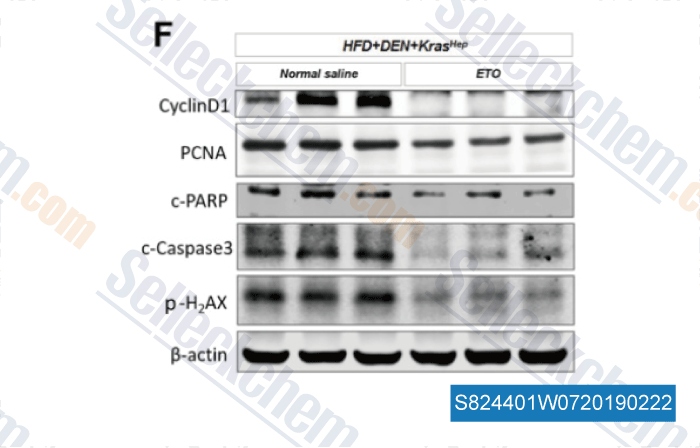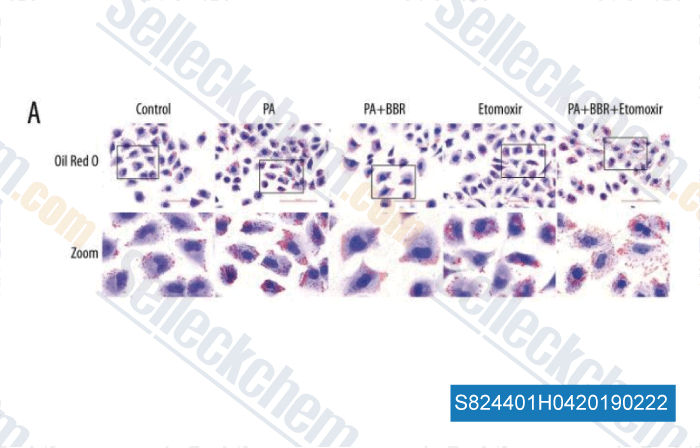|
Toll Free: (877) 796-6397 -- USA and Canada only -- |
Fax: +1-832-582-8590 Orders: +1-832-582-8158 |
Tech Support: +1-832-582-8158 Ext:3 Please provide your Order Number in the email. |
Technical Data
| Formula | C15H18ClO4.Na |
||||||
| Molecular Weight | 320.74 | CAS No. | 828934-41-4 | ||||
| Solubility (25°C)* | In vitro | DMSO | 64 mg/mL (199.53 mM) | ||||
| Water | 64 mg/mL (199.53 mM) | ||||||
| Ethanol | 11 mg/mL (34.29 mM) | ||||||
| In vivo (Add solvents to the product individually and in order) |
|
||||||
|
* <1 mg/ml means slightly soluble or insoluble. * Please note that Selleck tests the solubility of all compounds in-house, and the actual solubility may differ slightly from published values. This is normal and is due to slight batch-to-batch variations. * Room temperature shipping (Stability testing shows this product can be shipped without any cooling measures.) |
|||||||
Preparing Stock Solutions
Biological Activity
| Description | Etomoxir sodium salt ((R)-(+)-Etomoxir sodium salt) is an irreversible inhibitor of carnitine palmitoyltransferase-1 (CPT-1) on the outer face of the inner mitochondrial membrane. Etomoxir enhances palmitate-induced cell apoptosis. | ||
|---|---|---|---|
| Targets |
|
||
| In vitro | Etomoxir has also been identified as a direct agonist of PPARα. Etomoxir is a compound that binds irreversibly to the catalytic site of CPT-1 inhibiting its activity, but also upregulates fatty acid oxidation enzymes. Transcriptional effects of etomoxir could be due to 1. shift in energy metabolism with increased glucose utilization and 2. PPARalpha activation[1]. Etomoxir reduces pro-inflammatory cyokine production and increases apoptosis of MOG specific T cells[2]. Etomoxir has been shown to decrease oxygen consumption rates (OCRs) and impair ATP and NADPH production in the pediatric glioblastoma cell line SF188[3]. | ||
| In vivo | Etomoxir has a protective action on the ischemia/reperfusion injury of the kidney similarly to an established PPARalpha agonist. It has been developed for treating non-insulindependent diabetes mellitus. Etomoxir increases the functional recovery of fatty acid perfused ischemic rat hearts which is unrelated to changes in levels of long-chain acylcarnitines and is attributed to an increased glucose use. A chronic treatment of rats with etomoxir increases the SR Ca2+-ATPase activity, the Ca2+ uptake rate, the number of active Ca2+ pumps E~P, the SERCA2 protein and the SERCA2 mRNA abundance of the heart. At a low dosage, etomoxir has a selective influence on the rate of contraction and relaxation of overloaded hearts. Etomoxir, in the liver can act as peroxisomal proliferator, increasing DNA synthesis and liver growth[1]. Etomoxir-treated mice displays a reduced immune cell infiltration in the CNS with few macrophages, activated microglia, or T cells present. Etomoxir reduces inflammation and demyelination in the CNS of treated mice[2]. Inhibition of fatty acid oxidation by etomoxir prolongs survival time in a syngeneic mouse model of malignant glioma and slow tumor growth. Emergence and progression of glioma are delayed upon treatment with the investigational drug etomoxir. Etomoxir has already been tested in phase I/II clinical trials for treating moderate congestive heart failure; this trial is discontinued because 4 patients (of 226 taking the drug) developed unacceptably high liver transaminase levels upon treatment, and the risk of such drastic side effects is deemed sufficient to negate the potential benefit of this drug for these patients[3]. |
Protocol (from reference)
| Cell Assay: |
|
|---|---|
| Animal Study: |
|
References
|
Customer Product Validation

-
Data from [Data independently produced by , , Cancer Lett, 2018, 442:40-52]

-
Data from [Data independently produced by , , Med Sci Monit, 2018, 24:1484-1492]

-
Data from [Data independently produced by , , Med Sci Monit, 2018, 24: 1484-1492]

-
Data from [Data independently produced by , , Lymphatic Research and BiologyVol, 2018, 16(1). https://doi.org/10.1089/lrb.2017.0033]
Selleck's Etomoxir sodium salt has been cited by 45 publications
| Extracellular matrix stiffness as an energy metabolism regulator drives osteogenic differentiation in mesenchymal stem cells [ Bioact Mater, 2024, 35:549-563] | PubMed: 38434800 |
| PIM1 drives lipid droplet accumulation to promote proliferation and survival in prostate cancer [ Oncogene, 2024, 43(6):406-419] | PubMed: 38097734 |
| Targeting metabolic adaptive responses induced by glucose starvation inhibits cell proliferation and enhances cell death in osimertinib-resistant non-small cell lung cancer (NSCLC) cell lines [ Biochem Pharmacol, 2024, S0006-2952(24)00144-8] | PubMed: 38522556 |
| NINJ1 regulates ferroptosis via xCT antiporter interaction and CoA modulation [ bioRxiv, 2024, 2024.02.22.581432] | PubMed: 38464226 |
| Immuno-metabolic dendritic cell vaccine signatures associate with overall survival in vaccinated melanoma patients [ Nat Commun, 2023, 10.1038/s41467-023-42881-4] | PubMed: 37938561 |
| Restoration of CPT1A-mediated fatty acid oxidation in mesothelial cells protects against peritoneal fibrosis [ Theranostics, 2023, 13(13):4482-4496] | PubMed: 37649600 |
| Restoration of CPT1A-mediated fatty acid oxidation in mesothelial cells protects against peritoneal fibrosis [ Theranostics, 2023, 10.7150/thno.84921] | PubMed: 37649600 |
| Perturbation of Copper Homeostasis Sensitizes Cancer Cells to Elevated Temperature [ Int J Mol Sci, 2023, 25(1)423] | PubMed: 38203594 |
| Metabolomic analysis of pig spleen reveals African swine fever virus infection increased acylcarnitine levels to facilitate viral replication [ J Virol, 2023, 97(8):e0058623] | PubMed: 37582206 |
| Metabolomic analysis of pig spleen reveals African swine fever virus infection increased acylcarnitine levels to facilitate viral replication [ J Virol, 2023, 97(8):e0058623] | PubMed: 37582206 |
RETURN POLICY
Selleck Chemical’s Unconditional Return Policy ensures a smooth online shopping experience for our customers. If you are in any way unsatisfied with your purchase, you may return any item(s) within 7 days of receiving it. In the event of product quality issues, either protocol related or product related problems, you may return any item(s) within 365 days from the original purchase date. Please follow the instructions below when returning products.
SHIPPING AND STORAGE
Selleck products are transported at room temperature. If you receive the product at room temperature, please rest assured, the Selleck Quality Inspection Department has conducted experiments to verify that the normal temperature placement of one month will not affect the biological activity of powder products. After collecting, please store the product according to the requirements described in the datasheet. Most Selleck products are stable under the recommended conditions.
NOT FOR HUMAN, VETERINARY DIAGNOSTIC OR THERAPEUTIC USE.
